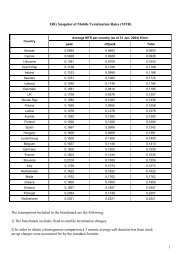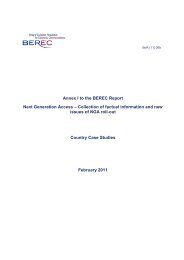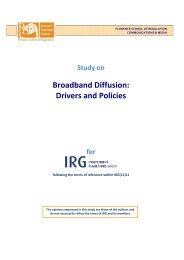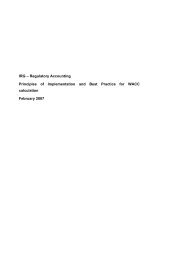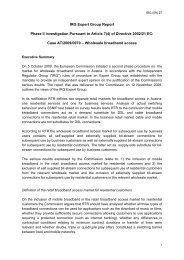16 Rev2b NGA Opinion Supplementary doc - IRG
16 Rev2b NGA Opinion Supplementary doc - IRG
16 Rev2b NGA Opinion Supplementary doc - IRG
You also want an ePaper? Increase the reach of your titles
YUMPU automatically turns print PDFs into web optimized ePapers that Google loves.
ERG (07) <strong>16</strong>rev2b <strong>NGA</strong> <strong>Opinion</strong> <strong>Supplementary</strong> Doc 43 / 69<br />
Figure 2.8-2: Operator (LLU) coverage (in % of active loops) according with the number of MDF.<br />
Moreover, the majority of MDF are located in small buildings, remote units or even street<br />
cabinets. In these cases, the only form of co-location will be, probably, in an exterior space,<br />
which will cause increased costs to the operators. At this moment, it is not possible to affirm<br />
that they would recoup these costs, in case that they decide to advance for a broader covering.<br />
On the other hand, it might not be interesting for the operators to be co-located in<br />
nodes/MDF with reduced potential capacity (in the order of the tens of loops), being more<br />
efficient to use the bitstream offer (with 100% of national coverage for ADSL 22 ) to offer its<br />
services. It should me noted, however, that the bitstream offer "only" allows broadband access,<br />
not being specifically suited to offer triple-play services at a wide scale 23 .<br />
This problem could be aggravated in the case of PTC, intending to introduce advanced xDSL<br />
technologies (e.g. VDSL2) across the territory, install or upgrade hundreds or even thousand<br />
street (or building) cabinets, i.e., dislocating the first aggregation node closer to the final user.<br />
In these conditions, it does not seem economically efficient that the operators have conditions<br />
to offer similar coverage, i.e., be co-located in all the access points/cabinets.<br />
Nevertheless, in the short term, and having into account the forecasts for the short term evolution<br />
of the MDF/PA, that the future strategy for the evolution/migration of the network is not<br />
yet clear and its concretion will never be immediate, in the short and medium term, it is not<br />
foreseen that the access network architecture can be substantially modified, potentially affecting<br />
the competitive conditions on the access to the network by the LLU operators.<br />
2.9 Romania<br />
NGN migration<br />
As in most of the EU countries, the traditional TDM networks in Romania are gradually migrating<br />
towards IP-based Next Generation Networks (NGN). Although it is not clear today<br />
how the NGN networks will look like in detail, the strategies already employed by the incum-<br />
22 PTC is currently upgrading its xDSL offers with ADSL2+, aiming approaching national coverage in the short<br />
term.<br />
23 Although an ATM aggregation offer is available, with QoS guaranties.



